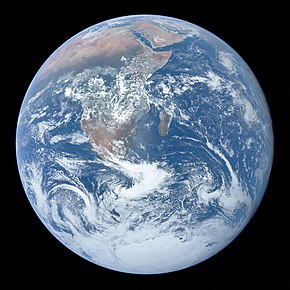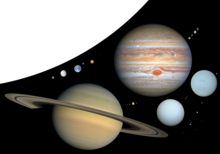
Back Адгьыл Abkhazian Bumoe ACE ЧӀыгу ADY Aarde Afrikaans Erde ALS መሬት Amharic Tierra AN Eorðe ANG धरती ANP الأرض Arabic
 The Blue Marble, Apollo 17, December 1972 | |||||||||||||
| Designations | |||||||||||||
|---|---|---|---|---|---|---|---|---|---|---|---|---|---|
| The world, the globe, Sol III, Terra, Tellus, Gaia, Mother Earth | |||||||||||||
| Adjectives | Earthly, terrestrial, terran, tellurian | ||||||||||||
| Symbol | |||||||||||||
| Orbital characteristics | |||||||||||||
| Epoch J2000[n 1] | |||||||||||||
| Aphelion | 152097597 km (94509065 mi) | ||||||||||||
| Perihelion | 147098450 km (91402740 mi)[n 2] | ||||||||||||
| 149598023 km (92955902 mi)[1] | |||||||||||||
| Eccentricity | 0.0167086[1] | ||||||||||||
| 365.256363004 d[2] (1.00001742096 aj) | |||||||||||||
Average orbital speed | 29.7827 km/s[3] (107218 km/h; 66622 mph) | ||||||||||||
| 358.617° | |||||||||||||
| Inclination |
| ||||||||||||
| −11.26064° – J2000 ecliptic[3] | |||||||||||||
| 2023-Jan-04[5] | |||||||||||||
| 114.20783°[3] | |||||||||||||
| Satellites | 1, the Moon | ||||||||||||
| Physical characteristics | |||||||||||||
Mean radius | 6371.0 km (3958.8 mi)[6] | ||||||||||||
Equatorial radius | 6378.137 km (3963.191 mi)[7][8] | ||||||||||||
Polar radius | 6356.752 km (3949.903 mi)[9] | ||||||||||||
| Flattening | 1/298.257222101 (ETRS89)[10] | ||||||||||||
| Circumference |
| ||||||||||||
| Volume | 1.08321×1012 km3 (2.59876×1011 cu mi)[3] | ||||||||||||
| Mass | 5.972168×1024 kg (1.31668×1025 lb)[13] | ||||||||||||
Mean density | 5513 kg/m3 (0.1992 lb/cu in)[3] | ||||||||||||
| 9.80665 m/s2 (32.1740 ft/s2)[14] | |||||||||||||
| 0.3307[15] | |||||||||||||
| 11.186 km/s (40270 km/h; 25020 mph)[3] | |||||||||||||
1.0 d (24h 00 m 00s) | |||||||||||||
Equatorial rotation velocity | 0.4651 km/s[17] (1674.4 km/h; 1040.4 mph) | ||||||||||||
| 23.4392811°[2] | |||||||||||||
| Albedo | |||||||||||||
| Temperature | 255 K (−18 °C; −1 °F) (blackbody temperature)[18] | ||||||||||||
| |||||||||||||
| Surface equivalent dose rate | 0.274 μSv/h[22] | ||||||||||||
| −3.99 | |||||||||||||
| Atmosphere | |||||||||||||
Surface pressure | 101.325 kPa (at sea level) | ||||||||||||
| Composition by volume |
| ||||||||||||
 |
| Objects |
|---|
| Lists |
| Planets |
|
|
Earth is the third planet from the Sun and the only astronomical object known to harbor life. This is enabled by Earth being a water world, the only one in the Solar System sustaining liquid surface water. Almost all of Earth's water is contained in its global ocean, covering 70.8% of Earth's crust. The remaining 29.2% of Earth's crust is land, most of which is located in the form of continental landmasses within Earth's land hemisphere. Most of Earth's land is somewhat humid and covered by vegetation, while large sheets of ice at Earth's polar deserts retain more water than Earth's groundwater, lakes, rivers and atmospheric water combined. Earth's crust consists of slowly moving tectonic plates, which interact to produce mountain ranges, volcanoes, and earthquakes. Earth has a liquid outer core that generates a magnetosphere capable of deflecting most of the destructive solar winds and cosmic radiation.
Earth has a dynamic atmosphere, which sustains Earth's surface conditions and protects it from most meteoroids and UV-light at entry. It has a composition of primarily nitrogen and oxygen. Water vapor is widely present in the atmosphere, forming clouds that cover most of the planet. The water vapor acts as a greenhouse gas and, together with other greenhouse gases in the atmosphere, particularly carbon dioxide (CO2), creates the conditions for both liquid surface water and water vapor to persist via the capturing of energy from the Sun's light. This process maintains the current average surface temperature of 14.76 °C (58.57 °F), at which water is liquid under atmospheric pressure. Differences in the amount of captured energy between geographic regions (as with the equatorial region receiving more sunlight than the polar regions) drive atmospheric and ocean currents, producing a global climate system with different climate regions, and a range of weather phenomena such as precipitation, allowing components such as nitrogen to cycle.
Earth is rounded into an ellipsoid with a circumference of about 40,000 km. It is the densest planet in the Solar System. Of the four rocky planets, it is the largest and most massive. Earth is about eight light-minutes away from the Sun and orbits it, taking a year (about 365.25 days) to complete one revolution. Earth rotates around its own axis in slightly less than a day (in about 23 hours and 56 minutes). Earth's axis of rotation is tilted with respect to the perpendicular to its orbital plane around the Sun, producing seasons. Earth is orbited by one permanent natural satellite, the Moon, which orbits Earth at 384,400 km (1.28 light seconds) and is roughly a quarter as wide as Earth. The Moon's gravity helps stabilize Earth's axis, causes tides and gradually slows Earth's rotation. Tidal locking has made the Moon always face Earth with the same side.
Earth, like most other bodies in the Solar System, formed 4.5 billion years ago from gas in the early Solar System. During the first billion years of Earth's history, the ocean formed and then life developed within it. Life spread globally and has been altering Earth's atmosphere and surface, leading to the Great Oxidation Event two billion years ago. Humans emerged 300,000 years ago in Africa and have spread across every continent on Earth. Humans depend on Earth's biosphere and natural resources for their survival, but have increasingly impacted the planet's environment. Humanity's current impact on Earth's climate and biosphere is unsustainable, threatening the livelihood of humans and many other forms of life, and causing widespread extinctions.[23]
Cite error: There are <ref group=n> tags on this page, but the references will not show without a {{reflist|group=n}} template (see the help page).
- ^ a b Cite error: The named reference
VSOP87was invoked but never defined (see the help page). - ^ a b Cite error: The named reference
IERSwas invoked but never defined (see the help page). - ^ a b c d e f g h i Cite error: The named reference
earth_fact_sheetwas invoked but never defined (see the help page). - ^ Cite error: The named reference
Allen294was invoked but never defined (see the help page). - ^ Park, Ryan (9 May 2022). "Horizons Batch Call for 2023 Perihelion". NASA/JPL. Retrieved 3 July 2022.
- ^ Cite error: The named reference
hbcp2000was invoked but never defined (see the help page). - ^ Cite error: The named reference
usnowas invoked but never defined (see the help page). - ^ a b World Geodetic System (WGS-84). Available online Archived 11 March 2020 at the Wayback Machine from National Geospatial-Intelligence Agency.
- ^ Cite error: The named reference
IERS2004was invoked but never defined (see the help page). - ^ Cite error: The named reference
WGS-84-2was invoked but never defined (see the help page). - ^ Cite error: The named reference
Pidwirny 2006_8was invoked but never defined (see the help page). - ^ Cite error: The named reference
earthmasswas invoked but never defined (see the help page). - ^ Cite error: The named reference
NIST2008was invoked but never defined (see the help page). - ^ Cite error: The named reference
Williams1994was invoked but never defined (see the help page). - ^ Cite error: The named reference
Allen296was invoked but never defined (see the help page). - ^ Cite error: The named reference
Cox2000was invoked but never defined (see the help page). - ^ "Atmospheres and Planetary Temperatures". American Chemical Society. 18 July 2013. Archived from the original on 27 January 2023. Retrieved 3 January 2023.
- ^ Cite error: The named reference
asu_lowest_tempwas invoked but never defined (see the help page). - ^ Jones, P. D.; Harpham, C. (2013). "Estimation of the absolute surface air temperature of the Earth". Journal of Geophysical Research: Atmospheres. 118 (8): 3213–3217. Bibcode:2013JGRD..118.3213J. doi:10.1002/jgrd.50359. ISSN 2169-8996.
- ^ Cite error: The named reference
asu_highest_tempwas invoked but never defined (see the help page). - ^ United Nations Scientific Committee on the Effects of Atomic Radiation (2008). Sources and effects of ionizing radiation. New York: United Nations (published 2010). Table 1. ISBN 978-92-1-142274-0. Retrieved 9 November 2012.
- ^ "What Is Climate Change?". United Nations. Retrieved 17 August 2022.